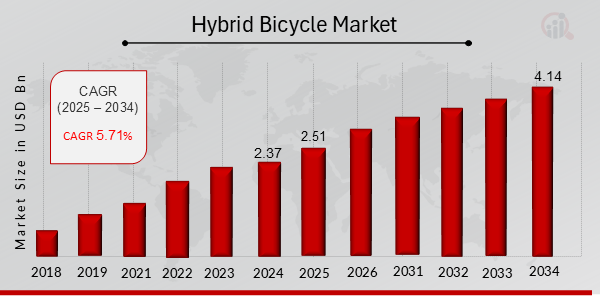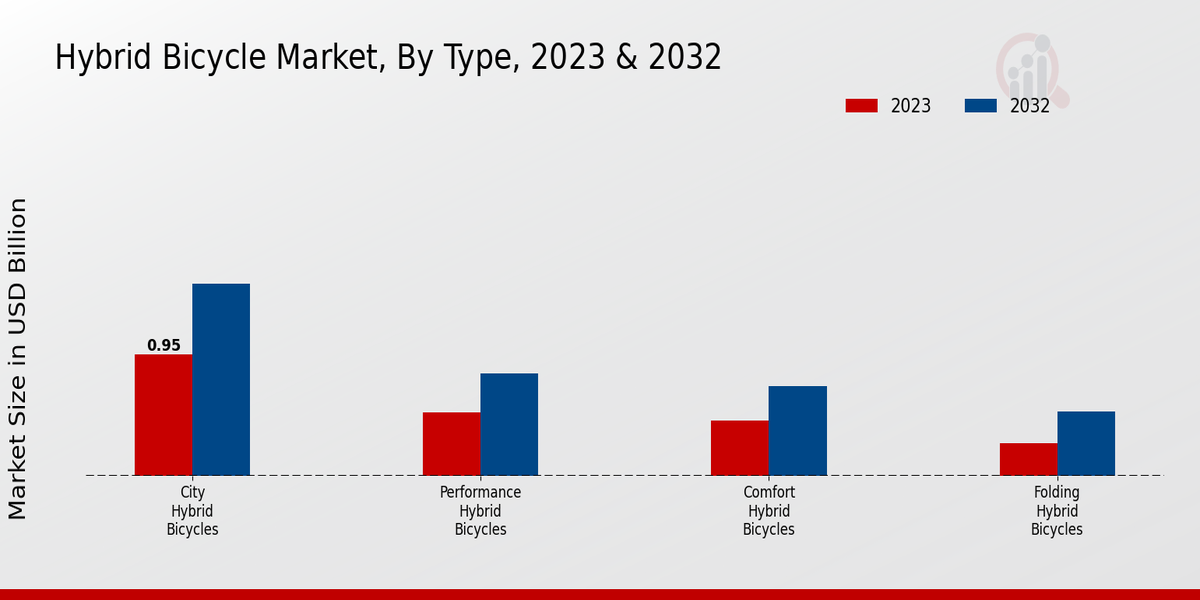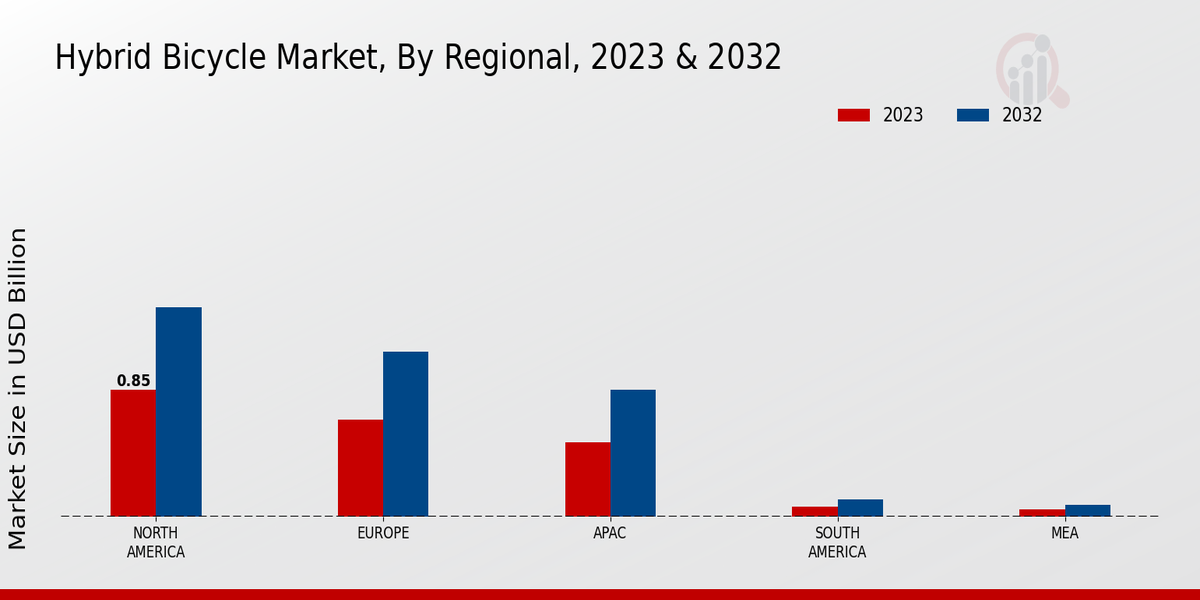Global Hybrid Bicycle Market Overview
As per MRFR analysis, the Hybrid Bicycle Market Size was estimated at 2.37 (USD Billion) in 2024. The Hybrid Bicycle Market Industry is expected to grow from 2.51 (USD Billion) in 2025 to 4.14 (USD Billion) till 2034, at a CAGR (growth rate) is expected to be around 5.71% during the forecast period (2025 - 2034).
Key Hybrid Bicycle Market Trends Highlighted
The Global Hybrid Bicycle Market is significantly influenced by various key market drivers, such as the growing focus on sustainability, increased health awareness, and rising urbanization. Many individuals are looking for eco-friendly transportation options that do not contribute to pollution. Hybrid bicycles offer an efficient solution as they combine elements of traditional cycling and electric biking, promoting a greener lifestyle.
Additionally, the rising costs of fuel and public transportation have prompted consumers to seek alternative modes of travel that are both economical and healthier. There are numerous opportunities to be explored in this market.The increasing demand for personal mobility solutions, especially amid urban congestion, presents a chance for manufacturers to innovate and enhance their product offerings.
Furthermore, the expansion of cycling infrastructure, such as dedicated bike lanes and parking areas, encourages more individuals to adopt hybrid bicycles. Collaboration between stakeholders, including local governments and businesses, can lead to further incentives for consumers to switch to these bikes. Additionally, exploring e-commerce platforms for sales could broaden customer reach and enhance market visibility.
In recent times, trends such as technological advancements in battery efficiency and lightweight materials are making hybrid bicycles more appealing.There is a notable shift towards smart features like integrated navigation, fitness tracking, and connectivity options that cater to tech-savvy users. The rising popularity of electric bikes, alongside growing consumer interest in outdoor activities and cycling as a hobby, relates to the overall acceptance of hybrid bicycles. These developments highlight the evolving landscape of personal transport, where companies must stay ahead by responding to changing consumer preferences and leveraging emerging technologies.

Source: Primary Research, Secondary Research, MRFR Database and Analyst Review
Hybrid Bicycle Market Drivers
Increasing Environmental Awareness
The rising awareness of environmental issues among consumers is a significant driver for the Global Hybrid Bicycle Market industry. With the increasing concerns over air pollution, greenhouse gas emissions, and climate change, more individuals are seeking sustainable modes of transportation. Hybrid bicycles represent a green alternative to traditional vehicles, as they produce no emissions and require no fossil fuels. As urban areas become more congested and the push for eco-friendly initiatives grows, hybrid bicycles are being recognized as an effective solution for reducing carbon footprints.
Local governments and organizations are also promoting cycling as a sustainable transport mode, leading to a greater acceptance and use of hybrid bicycles. In addition, many cities are developing cycling infrastructures, such as bike lanes and shared bike programs, further encouraging potential customers to consider hybrid bicycles as a viable transportation option. This trend towards sustainability not only promotes health and fitness among users but also strengthens the appeal of the Hybrid Bicycle Market Industry, aligning with the ethical values of today’s consumers who prefer environmentally friendly products.The ongoing movement towards electric bicycles, which often combine aspects of hybrid technology, further supports this market growth. As electric hybrid bicycles advance in technology and design, they become more attractive to a broader customer base, reinforcing the demand.
Urbanization and Traffic Congestion
The rapid urbanization across the globe has given rise to significant traffic congestion in major cities. Commuters are increasingly looking for efficient and convenient transportation options to navigate through congested urban landscapes. Hybrid bicycles offer an effective solution for this issue, allowing users to bypass traffic jams, reduce travel time, and provide flexibility in commuting. The growing urban population is leading to a rise in the demand for alternative modes of transportation that alleviate the pressure on public transport systems and reduce commuter frustration.
As cities invest in cycling infrastructure, such as improved bike lanes and secure parking facilities, the attractiveness of using hybrid bicycles increases, making them a preferred choice for many city dwellers. The trend of 'micro-mobility,' where shorter trips are favored, further supports the shift towards hybrid bicycles, thus positively impacting the Global Hybrid Bicycle Market industry.
Health and Fitness Trends
The increasing awareness of health and wellness among consumers is driving the Global Hybrid Bicycle Market industry. As more individuals recognize the importance of physical activity and its benefits, cycling has emerged as a popular form of exercise. Hybrid bicycles cater to a diverse audience, accommodating both casual riders and fitness enthusiasts. With the rise of lifestyle choices that prioritize health, many people are opting to integrate cycling into their daily routines, whether for commuting or leisure.Additionally, the hybrid bicycle's versatility allows users to enjoy recreational rides while also providing an effective workout, making them an attractive choice for health-conscious consumers. Gyms and wellness centers are also encouraging cycling as part of a balanced fitness regimen, further fueling demand for hybrid bicycles.
Hybrid Bicycle Market Segment Insights:
Hybrid Bicycle Market Type Insights
The Global Hybrid Bicycle Market is gaining traction, exhibiting a healthy market expansion driven by varying consumer preferences across different types. In 2023, the overall market value stands at 2.12 USD Billion, with projections indicating a valuation of 3.5 USD Billion by 2032. Within this evolving landscape, City Hybrid Bicycles takes the lead, with a valuation of 0.95 USD Billion in 2023, expected to grow to 1.5 USD Billion by 2032, demonstrating significant consumer demand for urban mobility solutions. This segment caters to commuters seeking efficiency and convenience, making it a majority holding in the market due to its practicality in urban environments.Performance Hybrid Bicycles, valued at 0.49 USD Billion in 2023, are projected to rise to 0.8 USD Billion by 2032, appealing to enthusiasts who prioritize speed and versatility. The increasing awareness of health and fitness, along with the rise of cycling as a sport, adds momentum to this segment, thus contributing to the Global Hybrid Bicycle Market growth. Comfort Hybrid Bicycles, on the other hand, demonstrate a market valuation of 0.43 USD Billion in 2023, growing to 0.7 USD Billion by 2032. This segment is particularly important for riders seeking ease and ergonomic designs, focusing on leisurely rides and longer distances without causing fatigue.Folding Hybrid Bicycles represent the niche segment, currently valued at 0.25 USD Billion in 2023, with an expected increase to 0.5 USD Billion by 2032. Although smaller in comparison, this segment is significant for urban dwellers with limited storage space, providing a smart and flexible transportation option. The variation in user preferences across the different types significantly impacts the Global Hybrid Bicycle Market segmentation, driving diverse marketing strategies and product innovations. Market trends indicate a growing inclination towards sustainable modes of transport, which bodes well for all segments, as cyclers increasingly recognize the environmental benefits of using hybrid bicycles.However, challenges still exist, such as competition from electric bicycles and the need for improved infrastructure to support cycling. The evolving landscape presents opportunities for growth within each type of hybrid bicycle, highlighting the importance of innovation and consumer-centric products to capture a larger market share. As the Global Hybrid Bicycle Market continues to expand, the player focus is shifting toward meeting the specific needs of diverse consumer bases, ensuring that each type of hybrid bicycle plays a crucial role in the overall market dynamics.

Source: Primary Research, Secondary Research, MRFR Database and Analyst Review
Hybrid Bicycle Market Design Insights
The Design segment plays a critical role, featuring variations such as Traditional, Modern, Portable and Ergonomic designs. Traditional bicycles appeal to those seeking classic aesthetics and familiarity, often capturing a large share of the market. Meanwhile, Modern designs attract a younger demographic focused on innovation and performance, resulting in a noteworthy contribution to the market growth.Portable designs are gaining traction due to urban living demands, providing convenience and ease of transport, which is becoming increasingly significant. Ergonomic bicycles, designed for comfort and efficiency, are emerging as a preferred choice for long-distance riders, suggesting that user comfort greatly influences purchasing decisions. As the Global Hybrid Bicycle Market data reflects a growing inclination toward these diverse design preferences, understanding their significance helps stakeholders identify opportunities for innovation and tailored marketing strategies, ultimately enhancing overall market growth.
Hybrid Bicycle Market Speed Insights
This segment encompasses configurations like Single Speed and Multi-Speed bicycles, which play crucial roles in traffic adaptability and user preferences. Multi-Speed bicycles dominate the market due to their flexibility in varied terrains, appealing to a wide range of riders looking for versatility in their cycling experience. On the other hand, Single Speed bicycles are gaining traction among urban commuters seeking simplicity and lower maintenance.The growing concern for eco-friendly transportation, coupled with rising fuel prices, acts as a significant growth driver for the Global Hybrid Bicycle Market, with consumers increasingly opting for efficient mobility solutions. Additionally, innovations in bike designs and technology present opportunities for enhanced user experiences. However, challenges such as price sensitivity and competition among various transport solutions may impact market growth. The emergence of smart hybrids integrated with technology is enhancing the market landscape, reflecting current trends toward sustainability and convenience.
Hybrid Bicycle Market Material Insights
The Material segment encompasses various elements like Aluminum, Steel, Carbon Fiber and Titanium, each playing a crucial role in shaping market growth. Aluminum remains a popular choice due to its lightweight and corrosion-resistant properties, contributing to the majority holding in hybrid bicycle production. Steel, known for its durability and stability, continues to attract consumers looking for reliability in their bicycles.Carbon Fiber offers a competitive advantage with its high strength-to-weight ratio, making it significant for performance-driven models. Lastly, Titanium, though positioned at a premium, appeals to niche markets seeking the best material quality. The growing demand for eco-friendly transport options and technological advancements are driving growth in the Global Hybrid Bicycle Market as various manufacturers adapt their offerings to meet the evolving preferences of consumers while navigating challenges like supply chain issues and fluctuating raw material costs.This thriving environment reflects the market's potential and highlights opportunities to perform enhancements across different material types.
Hybrid Bicycle Market Regional Insights
The Global Hybrid Bicycle Market revenue showcases a diverse regional landscape, with North America leading the charge in 2023, valued at 0.85 USD billion, and expected to grow to 1.4 USD billion by 2032. Europe follows closely with a valuation of 0.65 USD billion in 2023 and anticipated growth to 1.1 USD billion by 2032, highlighting its significant market presence. The APAC region, valued at 0.5 USD billion in 2023, is expected to rise to 0.85 USD billion, driven by increasing urbanization and eco-friendly transportation preferences. Meanwhile, South America and MEA sectors represent smaller market shares, with valuations of 0.07 USD billion and 0.05 USD billion, respectively, in 2023, suggesting emerging opportunities within these regions.The gradual growth in South America to 0.12 USD billion and MEA to 0.08 USD billion indicates a developing interest in hybrid bicycles, influenced by rising health consciousness and sustainability trends. Overall, the Global Hybrid Bicycle Market statistics highlight the varying growth dynamics across these regions, with North America and Europe dominating in revenue contribution, while APAC shows a notable potential for significant expansion in the coming years.

Source: Primary Research, Secondary Research, MRFR Database and Analyst Review
Hybrid Bicycle Market Key Players and Competitive Insights:
The Global Hybrid Bicycle Market has been rapidly evolving, driven by a growing demand for eco-friendly transportation solutions and a surge in outdoor recreational activities. This market has witnessed an increase in both the variety of products available and the number of players competing within it. As urban populations expand, the appeal of hybrid bicycles, which combine the features of road and mountain bikes, has risen significantly. Consumers are increasingly looking for versatility, comfort and performance, which leads to heightened competition among manufacturers striving to innovate and differentiate their products. The landscape is characterized by a mix of established brands and emerging players, all vying for market share by focusing on quality, design, and customer engagement.Cannondale Bicycle Corporation has carved out a significant niche in the Global Hybrid Bicycle Market. Renowned for its innovative approach and high-quality production, Cannondale offers a diverse range of hybrid bicycles that cater to a variety of riders, from casual cyclists to serious outdoors enthusiasts. The company is recognized for its strong brand presence and reputation for producing durable and reliable bicycles equipped with cutting-edge technology. Their commitment to research and development has enabled them to stay ahead of market trends, ensuring that they continue to meet consumer demands for lightweight frames, enhanced performance, and comfort.
Additionally, Cannondale's strategic partnerships and distribution networks have reinforced its market position, allowing for greater accessibility of its products to a global audience.Bianchi has established itself as another key player in the Global Hybrid Bicycle Market, recognized for its long-standing heritage and expertise in bicycle design. The company prides itself on its commitment to quality and craftsmanship, offering a range of hybrid bicycles that combine performance with style. Bianchi's unique designs and innovative engineering have attracted a loyal customer base, with many riders drawn to the brand for its aesthetic appeal and performance-oriented features. Their focus on sustainability and eco-friendly materials further resonates with today's environmentally conscious consumers, enhancing their competitive edge. Bianchi's ability to adapt to market trends, coupled with a strong international presence, allows it to consistently appeal to a diverse demographic of cycling enthusiasts who seek both functionality and elegance in their bicycles.
Key Companies in the Hybrid Bicycle Market Include:
- Cannondale Bicycle Corporation
- Bianchi
- Trek Bicycle Corporation
- Electra Bicycle Company
- Orbea
- Dahon
- Fuji Bikes
- Vector Cycle
- Kona Bicycle Company
- Merida Industry Co Ltd
- Scott Sports
- Specialized Bicycle Components
- Jamis Bicycles
- Giant Manufacturing Co Ltd
- Raleigh Bicycle Company
Hybrid Bicycle Market Industry Developments
Recent developments in the Global Hybrid Bicycle Market indicate a growing trend towards sustainability and eco-friendly transport solutions as consumers become more health-conscious and environmentally aware. Companies like Cannondale Bicycle Corporation and Trek Bicycle Corporation are innovating with new models that blend performance with comfort, catering to a wider demographic. Orbea and Bianchi have also introduced advanced hybrid designs focusing on lightweight materials, which enhance the riding experience. Dahon continues to lead in the folding bicycle segment, appealing to urban commuters.
In terms of mergers and acquisitions, Specialized Bicycle Components recently expanded its portfolio to include emerging brands, further solidifying its market presence. Scott Sports has been enhancing its product lines through strategic partnerships, aiming to leverage technology in hybrid bicycle design. Moreover, the market is experiencing significant growth as customers increasingly prefer bicycles for commuting due to rising fuel prices and urban congestion. The hybrid bicycle market is projected to continue expanding, driven by innovation and market demands, as manufacturers like Giant Manufacturing Co Ltd and Merida Industry Co Ltd invest heavily in R&D to meet the changing preferences of consumers.
Hybrid Bicycle Market Segmentation Insights
Hybrid Bicycle Market Type Outlook
- City Hybrid Bicycles
- Performance Hybrid Bicycles
- Comfort Hybrid Bicycles
- Folding Hybrid Bicycles
Hybrid Bicycle Market Design Outlook
- Traditional
- Modern
- Portable
- Ergonomic
Hybrid Bicycle Market Speed Outlook
Hybrid Bicycle Market Material Outlook
- Aluminum
- Steel
- Carbon Fiber
- Titanium
Hybrid Bicycle Market Regional Outlook
- North America
- Europe
- South America
- Asia Pacific
- Middle East and Africa
| Report Attribute/Metric |
Details |
|
Market Size 2024
|
2.37 (USD Billion)
|
|
Market Size 2025
|
2.51 (USD Billion)
|
|
Market Size 2034
|
4.14 (USD Billion)
|
|
Compound Annual Growth Rate (CAGR)
|
5.71% (2025 - 2034)
|
|
Report Coverage
|
Revenue Forecast, Competitive Landscape, Growth Factors, and Trends
|
|
Base Year
|
2024
|
|
Market Forecast Period
|
2025 - 2034
|
|
Historical Data
|
2019 - 2023
|
| Market Forecast Units |
USD Billion |
| Key Companies Profiled |
Cannondale Bicycle Corporation, Bianchi, Trek Bicycle Corporation, Electra Bicycle Company, Orbea, Dahon, Fuji Bikes, Vector Cycle, Kona Bicycle Company, Merida Industry Co Ltd, Scott Sports, Specialized Bicycle Components, Jamis Bicycles, Giant Manufacturing Co Ltd, Raleigh Bicycle Company |
| Segments Covered |
Type, Design, Speed, Material, Regional |
| Key Market Opportunities |
1. Rising urban cycling trends, 2. Increased demand for eco-friendly transport, 3. Growth in fitness consciousness, 4. Advancements in bicycle technology, 5. Expanding e-commerce platforms for sales |
| Key Market Dynamics |
1. Growing health consciousness, 2. Urban commuting trends, 3. Environmental sustainability concerns, 4. Advances in bicycle technology, 5. Expanding e-commerce distribution channels |
| Countries Covered |
North America, Europe, APAC, South America, MEA |
Frequently Asked Questions (FAQ) :
The Hybrid Bicycle Market was expected to be valued at 4.14 USD Billion by 2034.
The expected CAGR for the Hybrid Bicycle Market from 2025 to 2034 is 5.71%.
North America is projected to hold the largest market size, valued at 1.4 USD Billion by 2032.
The market size of City Hybrid Bicycles is expected to reach 1.5 USD Billion by 2032.
Key players in the Hybrid Bicycle Market include Cannondale, Trek Bicycle Corporation, and Specialized Bicycle Components.
The projected market value for Comfort Hybrid Bicycles is estimated to be 0.7 USD Billion by 2032.
The APAC region is expected to grow to a market size of 0.85 USD Billion by 2032.
The Folding Hybrid Bicycles segment is anticipated to be valued at 0.5 USD Billion by 2032.
The projected market size of Performance Hybrid Bicycles is expected to reach 0.8 USD Billion by 2032.
Challenges include fluctuating raw material prices and increasing competition in the industry.

















